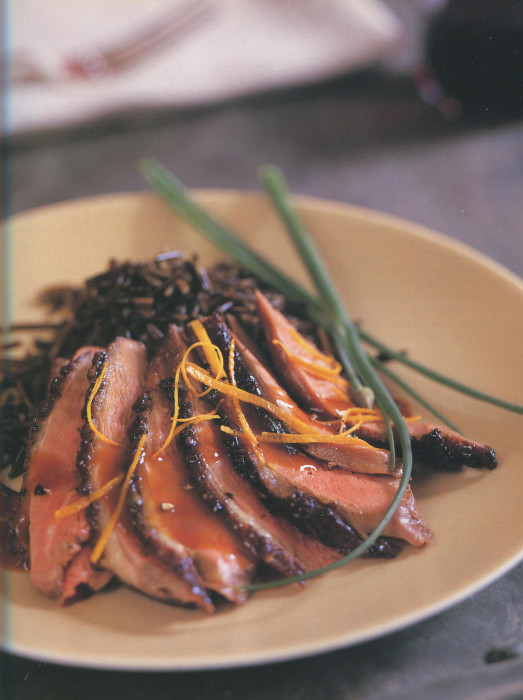Cliché is, of course, a French word. And you may think that it is centuries old, but it is not. The word only appeared in the mid-19th century and did not accelerate in use until around World War II. So cliché is relatively young. On the other hand Duck à L’Orange is definitely not a cliché, but it is not “classic” as in “old” either. Italians claim they originated the dish, which migrated to France but only gained international fame thanks to British enthusiasm in the 1960s. The first cookbook references to it, in English, appear in the early 1960s.
Acclaimed author James Peterson wrote The Duck Cookbook and here is his version of this duck classic. Make it once, and it may become a habit. It will never be a cliché
Duck à L’Orange
Yield: 4 main course servings
Ingredients:
- 4 Pekin (Long Island) duck breasts or 2 mullard breasts (1 ½ to 2 pounds total)
- Salt and pepper
- 12 kumquats or 1 juicing orange
- 1 cup water
- 1 cup concentrated duck broth, ¼ cup homemade duck glaze, or 2 tablespoons commercial glaze
- ¼ teaspoon sugar
- 2 tablespoons Grand Marnier
- 2 tablespoons balsamic, sherry, or red wine vinegar, or more to taste
- 3 tablespoons cold unsalted butter
- Orange wedges
Preparation:
Use a sharp knife to score the skin side of the duck breasts in two directions, about 20 slashes per direction. Season the breasts on both sides with salt and pepper. Reserve in the refrigerator.
Cut the round ends off the kumquats and eat or discard them. Set the kumquats on one end and use a sharp paring knife to trim the zests off six of them. Cut all the kumquats in half lengthwise, and working over a strainer set in a nonreactive bowl, remove the pulp with a small spoon. Push the pulp against the strainer to extract the juice. (Don’t worry if you end up with only a tablespoon or two.) Place the kumquat zests on a cutting board and slice them into fine julienne. Bring the 1 cup water to a boil over high heat, blanch the zests for 1 minute, then drain them in a strainer.
If you’re using the orange instead, cut off one end so the orange can stand on the cutting board, and slice off four 2-inch strips of zest. Cut the zest into fine julienne, then blanch the zest for 1 minute in the cup of boiling water. Juice the orange, strain the juice into a saucepan, and boil it until it’s reduced to about 2 tablespoons.
If you’re using concentrated duck broth, reduce it in a small saucepan to about ¼ cup—until it’s lightly syrupy.
Heat a sauté pan over medium to high heat and sauté the duck breasts, skin side down, 8 to 10 minutes for the Pekin duck breasts and 12 to 18 minutes for the mullard. Turn the breasts over, adjust the heat to high, and cook for 1 minute for the Pekin ducks and 2 minutes for the mullard.
Pour the fat out of the pan—if it hasn’t burned, save it for omelets—and deglaze the pan with the reduced kumquat or orange juice. Use a whisk to add the glaze. Add the sugar, Grand Marnier, kumquat or orange zest, and vinegar, and simmer the sauce for about 30 seconds to cook off the alcohol. At this point, adjust the thickness of the sauce—its consistency is up to you, but many cooks make their sauces too thick; add 1 or 2 teaspoons water to thin it or simmer the sauce for a moment to reduce and thicken it. Whisk in the cold butter, keeping the pan and whisk moving until all the butter melts. (Don’t let it sit without whisking or the butter will separate.) Season to taste with salt, pepper, and if necessary, a few more drops of vinegar.
Slice the breasts crosswise, arrange the slices on individual heated plates, and spoon the sauce over the breasts. Serve hot, with the orange wedges if desired.
VARIATION: You can substitute two Pekin duck breasts plus two braised duck legs or slow- roasted duck legs. If you’re using the braised duck legs, pull off the skin and discard it and pull the meat away from the bone. To reheat the duck meat, put it in a small saucepan—it’s okay if it’s a bit shredded—with ¼ cup of the braising liquid, cover the pan, and put it over low heat. You can also reheat it in the microwave.
For the sauce, reduce another 1 ¼ cup of the braising liquid in a small saucepan until it’s lightly syrupy and measures about ½ cup. You can flavor the reduced braising liquid as described in the recipe above, using the juice of virtually any fruit. (Usually the juice is released as the fruit, say peaches, is lightly cooked, not by processing the fruit in a juicer.) The sauce may also be finished with about 4 tablespoons heavy cream or 2 tablespoons butter.
Source: The Duck Cookbook by James Peterson [Stewart Tabori & Chang, 2003]

